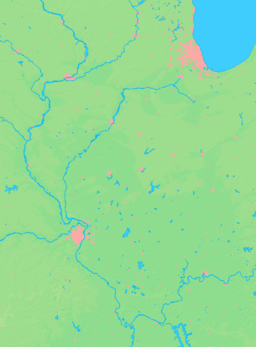Middletown, Illinois
| Middletown | |
| Village | |
| Country | United States |
|---|---|
| State | Illinois |
| County | Logan |
| Elevation | 581 ft (177 m) |
| Coordinates | 40°6′2″N 89°35′29″W / 40.10056°N 89.59139°WCoordinates: 40°6′2″N 89°35′29″W / 40.10056°N 89.59139°W |
| Area | 0.24 sq mi (1 km2) |
| - land | 0.24 sq mi (1 km2) |
| - water | 0.00 sq mi (0 km2) |
| Population | 324 (2010) |
| Density | 1,809.5/sq mi (699/km2) |
| Timezone | CST (UTC-6) |
| - summer (DST) | CDT (UTC-5) |
| Postal code | 62666 |
| Area code | 217 |
  Location of Middletown within Illinois | |
| Wikimedia Commons: Middletown, Illinois | |
Middletown is a village in Logan County, Illinois, United States. The population was 324 at the 2010 census, down from 434 in 2000.
Geography
Middletown is located at 40°6′2″N 89°35′29″W / 40.10056°N 89.59139°W (40.100685, -89.591448).[1]
According to the 2010 census, Middletown has a total area of 0.24 square miles (0.62 km2), all land.[2]
History
Middletown, founded in 1832, is the oldest town in Logan County. At one time, Middletown was considered as a location for the capital of Illinois. Middletown was a frequent overnight stop for legislators traveling between Springfield and Peoria in the mid-to-late 19th century. The Stage Coach Inn, located off the town square, is the oldest such wooden structure in Illinois. It is believed that Abraham Lincoln stayed at the Inn. Unfortunately, official records were destroyed in a fire many years ago.
The town does have at least one official and verified link to Abe Lincoln as he surveyed the site which would become the town during his early days surveying in Logan County.
Middletown is also home to the Knapp library and museum. The Knapp building is the oldest brick building in Logan county.
Several hot air balloon records were set in Middletown and the historic Vin Fiz, the first cross country flight, counts Middletown as one of the stops on that journey.
Middletown celebrated its Terquasquicentennial (175th birthday) during June 2007.
Demographics
| Historical population | |||
|---|---|---|---|
| Census | Pop. | %± | |
| 1860 | 361 | — | |
| 1870 | 223 | −38.2% | |
| 1910 | 751 | — | |
| 1920 | 587 | −21.8% | |
| 1930 | 507 | −13.6% | |
| 1940 | 496 | −2.2% | |
| 1950 | 480 | −3.2% | |
| 1960 | 543 | 13.1% | |
| 1970 | 626 | 15.3% | |
| 1980 | 503 | −19.6% | |
| 1990 | 436 | −13.3% | |
| 2000 | 434 | −0.5% | |
| 2010 | 324 | −25.3% | |
| Est. 2015 | 313 | [3] | −3.4% |
As of the census[5] of 2000, there were 434 people, 162 households, and 110 families residing in the village. The population density was 1,809.5 people per square mile (698.2/km²). There were 181 housing units at an average density of 754.7 per square mile (291.2/km²). The racial makeup of the village was 97.00% White, 0.23% African American, 0.46% Native American, 1.15% from other races, and 1.15% from two or more races. Hispanic or Latino of any race were 1.38% of the population.
There were 162 households out of which 40.7% had children under the age of 18 living with them, 51.2% were married couples living together, 13.0% had a female householder with no husband present, and 31.5% were non-families. 28.4% of all households were made up of individuals and 13.0% had someone living alone who was 65 years of age or older. The average household size was 2.68 and the average family size was 3.30.
In the village the population was spread out with 30.9% under the age of 18, 8.1% from 18 to 24, 29.5% from 25 to 44, 19.6% from 45 to 64, and 12.0% who were 65 years of age or older. The median age was 34 years. For every 100 females there were 93.8 males. For every 100 females age 18 and over, there were 85.2 males.
The median income for a household in the village was $33,929, and the median income for a family was $44,375. Males had a median income of $33,125 versus $21,875 for females. The per capita income for the village was $14,478. About 11.1% of families and 16.1% of the population were below the poverty line, including 28.1% of those under age 18 and 4.8% of those age 65 or over.
References
- ↑ "US Gazetteer files: 2010, 2000, and 1990". United States Census Bureau. 2011-02-12. Retrieved 2011-04-23.
- ↑ "G001 - Geographic Identifiers - 2010 Census Summary File 1". United States Census Bureau. Retrieved 2015-12-19.
- ↑ "Annual Estimates of the Resident Population for Incorporated Places: April 1, 2010 to July 1, 2015". Retrieved July 2, 2016.
- ↑ "Census of Population and Housing". Census.gov. Retrieved June 4, 2015.
- ↑ "American FactFinder". United States Census Bureau. Retrieved 2008-01-31.